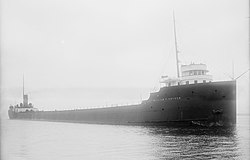St. Mary's Challenger
|
The freighter under its first name William P. Snyder between 1907 and 1910
|
||||||||||||||
|
||||||||||||||
|
||||||||||||||
|
||||||||||||||
|
||||||||||||||
The St. Marys Challenger was a steam-powered cargo ship used on the Great Lakes from 1906 to 2013 . Towards the end of her 107-year career as a self-propelled ship, she was the last cargo ship powered in this way in this trade area. After the decommissioning in 2013, the owner had the drive removed and continues to use the hull as a non-powered barge for transporting cement.
History of the vehicle
Steam operation
After a previous order for a 551- foot- long vehicle for the flourishing iron ore trade from Minnesota at the beginning of the 20th century , the freighter named William P. Snyder was launched on February 7, 1906 at the builder Great Lakes Engineering Works in Ecorse, Michigan ) . Soon the freighter's transport services were in high demand from an industry that needed ever larger quantities of iron and steel for the production of automobiles, consumer goods and military material for use in the First World War.
Originally equipped with two shell boilers , the ship, now underway as Elton Hoyt II , was equipped with two water tube boilers in 1950 to supply the likewise new Skinner Marine Uniflow steam engine.
After this machine conversion, the ship, which was now too small for economical transport of ore, changed owners and names several times in the 1960s. But it remained true to a new role assigned to it as a cement carrier. Its cargo landed at numerous construction companies around the Great Lakes, while Charlevoix (Michigan) served as its home port .
Towards the end of its more than one hundred years of service, the ship, now under its last name St. Mary's Challenger , was a popular motif of ship spotters on the Great Lakes, as it was the last example of a steamship in riveted construction from the time of the second industrial revolution .
Conversion to a barge
In November 2013 came the end of its use as a self-propelled ship for the St. Marys Challenger . Her last voyage took her to the Bay Shipbuilding Co. in Sturgeon Bay (Wisconsin) , where the stern with the drive was cut off, the wheelhouse was dismantled and the hull was prepared with a newly constructed stern for use as a barge driven in conjunction with a pushboat . At the time of docking, the shipyard expected a conversion time until May 2014.
The wheelhouse has been preserved and has been on display at the National Museum of the Great Lakes in Toledo (Ohio) since spring 2015 .
See also
- The Badger ship , still in operation today, powered by coal-fired boilers and a piston steam engine
Web links
Individual evidence
- ↑ a b c d e Great Lakes Fleet Page Vessel Feature - St. Marys Challenger . In: boatnerd.com . Retrieved May 18, 2016.
- ^ Toledo museum adds piece of Great Lakes history , Toledo Blade . April 4, 2015. Retrieved May 18, 2016.

